Permeability Coefficient of Concrete under Complex Stress States
Abstract
:1. Introduction
2. Permeability Experiment of Concrete
2.1. Sample Preparation and Experimental Scheme
- Six concrete samples of good quality were selected and numbered as 1# to 6#;
- Before the experiment, the concrete samples were immersed in water to achieve thorough water saturation. The weight before and after immersion was measured, and the porosity of the concrete was calculated based on the weight change. The aggregate content of the concrete samples was calculated based on the density of the aggregate and the density of the mortar material;
- The samples were placed in the experimental machine, and radial confining pressure was first applied to the samples. After the confining pressure reached the set value and stabilized, the bottom surface was subjected to seepage pressure (water entered from the bottom and exited from the top). The seepage pressure was increased to the set value and stabilized, and the permeability of the concrete under these confining and seepage pressure conditions was calculated. Subsequently, an analysis of the differences was conducted;
- Axial pressure was gradually applied to the samples until failure, and the axial strain and the amount of seepage during the loading process were measured.
2.2. Measured Value of Permeability Coefficient
3. Analysis of Experimental Results
- Under the same seepage pressure and different confining pressures, the permeability coefficient of the sample decreases with increasing confining pressure (the red solid line is below the blue solid line). The magnitude of the reduction increases with increasing seepage pressure, with corresponding reductions of 5.6%, 18.2%, and 37.5% for seepage pressures of 1 MPa, 2 MPa, and 3 MPa, respectively. This is due to the fact that the internal pores and cracks of the concrete sample are gradually compacted and closed under the action of the confining pressure, the seepage channels are narrowed, and the deformation generated within the concrete material acts as a form of obstruction and inhibition to the passage of fluid.
- Under the same confining pressure and different seepage pressures, the permeability coefficient of the sample decreases with increasing seepage pressure (the red and blue lines in Figure 3 both show a decreasing trend). The reason for this phenomenon can be analyzed from the perspective that the seepage channels in the concrete sample are composed of multiple simple pipes with length and diameter (“simple pipes” refer to pipes with constant diameters and no branching). This experiment conforms to the free outflow characteristic in the hydraulic calculation of simple pipes, and the expression for the flow rate through a single simple pipe is Equation (2) [25].where is the cross-sectional area of the pipe for water flow, is the difference in water heads, and is the flow coefficient of the pipeline system, determined by the following equation:where is the coefficient of friction along the pipe, which is a function of the fluid Reynolds coefficient , and is the sum of the local head loss coefficients in the pipe. We can assume that the flow rates of the concrete sample in different head differences and (i.e., different seepage pressures and ) are and , respectively. For the same concrete sample under different head differences, it can be assumed that and do not change, and thus the flow coefficient of the pipeline system does not change, which results in Equation (4).where ( is the seepage pressure), which in turn leads to Equation (5).According to Equation (1) obtained from Darcy’s law, Equation (5) can be written as follows:It can be observed that the permeability coefficient of the concrete sample is inversely proportional to the square root of the seepage pressure, i.e., the greater the seepage pressure, the smaller the permeability coefficient. The dashed lines in Figure 3 represent the calculated values obtained using Equation (6) (assuming that the calculated value when the seepage pressure is 1 MPa is the same as the measured value). The reason for the discrepancy between the calculated values (dashed lines) and measured values (solid lines) is that some assumptions are made in the derivation of Equation (6). However, the trend of decreasing permeability coefficient with increasing seepage pressure is the same for both calculated and measured values.
- I.
- After applying axial compression, the compressive stress starts increasing from zero. With the increase in deformation, the stress–strain curve exhibits an ascending trend with a progressively accelerating rate, revealing the material’s inherent “locking” effect. This effect is attributed to the gradual closure of the pores and micro-cracks existing in the concrete. Therefore, the permeability coefficient decreases with the increase in axial strain.
- II.
- The stress–strain curve is basically linearly elastic. Although the permeability coefficient increases with the increase in axial strain, the change is not significant, and it remains relatively stable.
- III.
- The stress–strain curve enters the strengthening stage. As the axial strain increases, the permeability coefficient increases significantly at a higher rate. This is because the concrete begins to become damaged in this stage, and internal micro-cracks and pores increase. Meanwhile, new cracks emerge and connect, resulting in an increase in seepage channels.
- IV.
- This stage is the softening stage of the stress–strain curve. As the axial strain continues to increase, macroscopic cracks appear in the concrete, leading to a sharp increase in the permeability coefficient. The sudden increase in the permeability coefficient occurs roughly near the peak point of the stress–strain curve. In the later part of this stage, the change in the permeability coefficient becomes extremely unstable and discontinuous; thus, the permeability coefficient calculated at this time no longer conforms to the assumption of Darcy’s law and is not plotted in Figure 4.
4. Relationship between Permeability Coefficient and Volume Strain
4.1. Relationship Based on Experimental Results
4.2. Application of Dynamic Variation in Permeability Coefficient in Numerical Simulation
5. Conclusions
- Qualitative and quantitative variations in the concrete permeability coefficient under different confining pressures and seepage pressures are revealed, and are explained in terms of both the mechanism and formula derivation.
- The variation law of the concrete permeability coefficient under axial compression is revealed, and is described in stages.
- A quantitative expression of the relationship between the concrete permeability coefficient and volume strain is established, which can provide a scientific basis for the determination of the permeability coefficient in the analysis of the whole failure process of concrete seepage–stress coupling.
- The result of Conclusion 3 is applied to the numerical simulation of concrete seepage–stress coupling, and the result shows that it has good applicability in the subsequent numerical simulation analysis.
Author Contributions
Funding
Institutional Review Board Statement
Informed Consent Statement
Data Availability Statement
Acknowledgments
Conflicts of Interest
References
- Su, H.; Zhang, N.; Li, H. Concrete piezoceramic smart module pairs-based damage diagnosis of hydraulic structure. Compos. Struct. 2018, 183, 582–593. [Google Scholar] [CrossRef]
- Zhao, J.; Cai, G.; Gao, D.; Zhao, S. Influences of freeze–thaw cycle and curing time on chloride ion penetration resistance of Sulphoaluminate cement concrete. Constr. Build. Mater. 2014, 53, 305–311. [Google Scholar] [CrossRef]
- Qin, Y.; Duan, M.; Ma, W.; Li, Y.; Zhou, H.; Lv, Y.; Li, M. Experimental study on the damage permeability of polypropylene fiber-reinforced concrete. Constr. Build. Mater. 2021, 286, 122592. [Google Scholar] [CrossRef]
- Wang, X.H.; Zhang, S.R.; Wang, C.; Cui, W.; Cao, K.L.; Fang, X. Blast-induced damage and evaluation method of concrete gravity dam subjected to near-field underwater explosion. Eng. Struct. 2020, 209, 109996. [Google Scholar] [CrossRef]
- Yi, S.T.; Hyun, T.Y.; Kim, J.K. The effects of hydraulic pressure and crack width on water permeability of penetration crack-induced concrete. Constr. Build. Mater. 2011, 25, 2576–2583. [Google Scholar] [CrossRef]
- Yankelevsky, D.Z. Resistance of a concrete target to penetration of a rigid projectile-revisited. Int. J. Impact Eng. 2017, 106, 30–43. [Google Scholar] [CrossRef]
- Gawin, D.; Pesavento, F.; Schrefler, B.A. Simulation of damage–permeability coupling in hygro-thermo-mechanical analysis of concrete at high temperature. Commun. Numer. Methods Eng. 2002, 18, 113–119. [Google Scholar] [CrossRef]
- Koniorczyk, M.; Gawin, D.; Schrefler, B.A. Modeling evolution of frost damage in fully saturated porous materials exposed to variable hygro-thermal conditions. Comput. Methods Appl. Mech. Eng. 2015, 297, 38–61. [Google Scholar] [CrossRef]
- Pijaudier-Cabot, G.; Dufour, F.; Choinska, M. Permeability due to the increase of damage in concrete: From diffuse to localized damage distributions. J. Eng. Mech. 2009, 135, 1022–1028. [Google Scholar] [CrossRef]
- Choinska, M.; Khelidj, A.; Chatzigeorgiou, G.; Pijaudier-Cabot, G. Effects and interactions of temperature and stress-level related damage on permeability of concrete. Cem. Concr. Res. 2007, 37, 79–88. [Google Scholar] [CrossRef] [Green Version]
- Chatzigeorgiou, G.; Picandet, V.; Khelidj, A.; Pijaudier-Cabot, G. Coupling between progressive damage and permeability of concrete: Analysis with a discrete model. Int. J. Numer. Anal. Methods Geomech. 2005, 29, 1005–1018. [Google Scholar] [CrossRef] [Green Version]
- Dormieux, L.; Kondo, D.; Ulm, F.J. A micromechanical analysis of damage propagation in fluid-saturated cracked media. Comptes Rendus Mec. 2006, 334, 440–446. [Google Scholar] [CrossRef]
- Dormieux, L.; Kondo, D. Micromechanics of damage propagation in fluid-saturated cracked media. Rev. Eur. Génie Civ. 2007, 11, 945–962. [Google Scholar]
- Ijam, A.Z. Conformal analysis of seepage below a hydraulic structure with an inclined cutoff. Int. J. Numer. Anal. Methods Geomech. 1994, 18, 345–353. [Google Scholar] [CrossRef]
- Ahmed, A.A. Stochastic analysis of seepage under hydraulic structures resting on anisotropic heterogeneous soils. J. Geotech. Geoenviron. Eng. 2013, 139, 1001–1004. [Google Scholar] [CrossRef]
- Kamble, R.K.; Muralidhar, B.; Hanumanthappa, M.S.; Patil, A.V.; Edlabadkar, J.S. Multiple approaches to analyse and control seepage in hydraulic structures. ISH J. Hydraul. Eng. 2014, 20, 7–13. [Google Scholar] [CrossRef]
- Hassan, W.H. Application of a genetic algorithm for the optimization of a location and inclination angle of a cut-off wall for anisotropic foundations under hydraulic structures. Geotech. Geol. Eng. 2019, 37, 883–895. [Google Scholar] [CrossRef]
- Liu, H.; Zhang, Q.; Gu, C.; Su, H.; Li, V. Influence of microcrack self-healing behavior on the permeability of Engineered Cementitious Composites. Cem. Concr. Compos. 2017, 82, 14–22. [Google Scholar] [CrossRef]
- Liu, H.; Zhang, Q.; Gu, C.; Su, H.; Li, V.C. Influence of micro-cracking on the permeability of engineered cementitious composites. Cem. Concr. Compos. 2016, 72, 104–113. [Google Scholar] [CrossRef]
- Rivera, A.; Ledoux, E.; De Marsily, G. Nonlinear modeling of groundwater flow and total subsidence of the Mexico City aquifer-aquitard system. Land Subsid. 1991, 200, 45–58. [Google Scholar]
- Louis, C. Rock Hydraulics, 1st ed.; Müller: Udine, Italy, 1974; pp. 299–387. [Google Scholar]
- Xu, L.; Jiang, L.; Jin, Y.; Zhang, J.; Ren, Q. Long-term service performance analysis of the tunnel under high external water pressure considering grouting zone deterioration. Chin. J. Undergr. Space Eng. 2022, 18, 1842–1852. [Google Scholar]
- Zhao, J.; Zhang, Z. Coupled simulation of meso-damage and seepage during the process of concrete failure. J. Hohai Univ. 2008, 36, 71–75. [Google Scholar]
- Ministry of Housing and Urban-Rural Development of the People’s Republic of China. Specification for Mix Proportion Design of Ordinary Concrete (JGJ 55-2011), 1st ed.; China Architecture & Building Press: Beijing, China, 2011; pp. 11–19. [Google Scholar]
- Wu, C. Basic formula for simple pipe hydraulics calculation. In Hydraulics, 4th ed.; State Key Laboratory of Sichuan University: Chengdu China; Higher Education Press: Beijing, China, 2007; Volume 1, pp. 159–160. [Google Scholar]
- Li, R.; Yang, Y.S.; Pan, J.; Pereira, G.G.; Taylor, J.A.; Clennell, B.; Zou, C. Lattice Boltzmann modeling of permeability in porous materials with partially percolating voxels. Phys. Rev. E 2014, 90, 033301. [Google Scholar] [CrossRef] [PubMed]
- Federico, S.; Herzog, W. On the permeability of fibre-reinforced porous materials. Int. J. Solids Struct. 2008, 45, 2160–2172. [Google Scholar] [CrossRef] [Green Version]
- Hommel, J.; Coltman, E.; Class, H. Porosity–permeability relations for evolving pore space: A review with a focus on (bio-) geochemically altered porous media. Transp. Porous Media 2018, 124, 589–629. [Google Scholar] [CrossRef] [Green Version]
- Liu, H.L.; Hwang, W.R. Permeability prediction of fibrous porous media with complex 3D architectures. Compos. Part A Appl. Sci. Manuf. 2012, 43, 2030–2038. [Google Scholar] [CrossRef]
- Hendrick, A.G.; Erdmann, R.G.; Goodman, M.R. Practical considerations for selection of representative elementary volumes for fluid permeability in fibrous porous media. Transp. Porous Media 2012, 95, 389–405. [Google Scholar] [CrossRef]
- Deng, Y.; Liu, C.; Huang, R.; Wang, Y. Advanced Seepage Theory and Methods, 1st ed.; Science Press: Beijing, China, 2004; pp. 18–26. [Google Scholar]
- Tao, M.; Ren, Q.; Bian, H.; Cao, M.; Jia, Y. Mechanical Properties of Soil-Rock Mixture Filling in Fault Zone Based on Mesostructure. CMES-Comput. Model. Eng. Sci. 2022, 132, 680–705. [Google Scholar] [CrossRef]

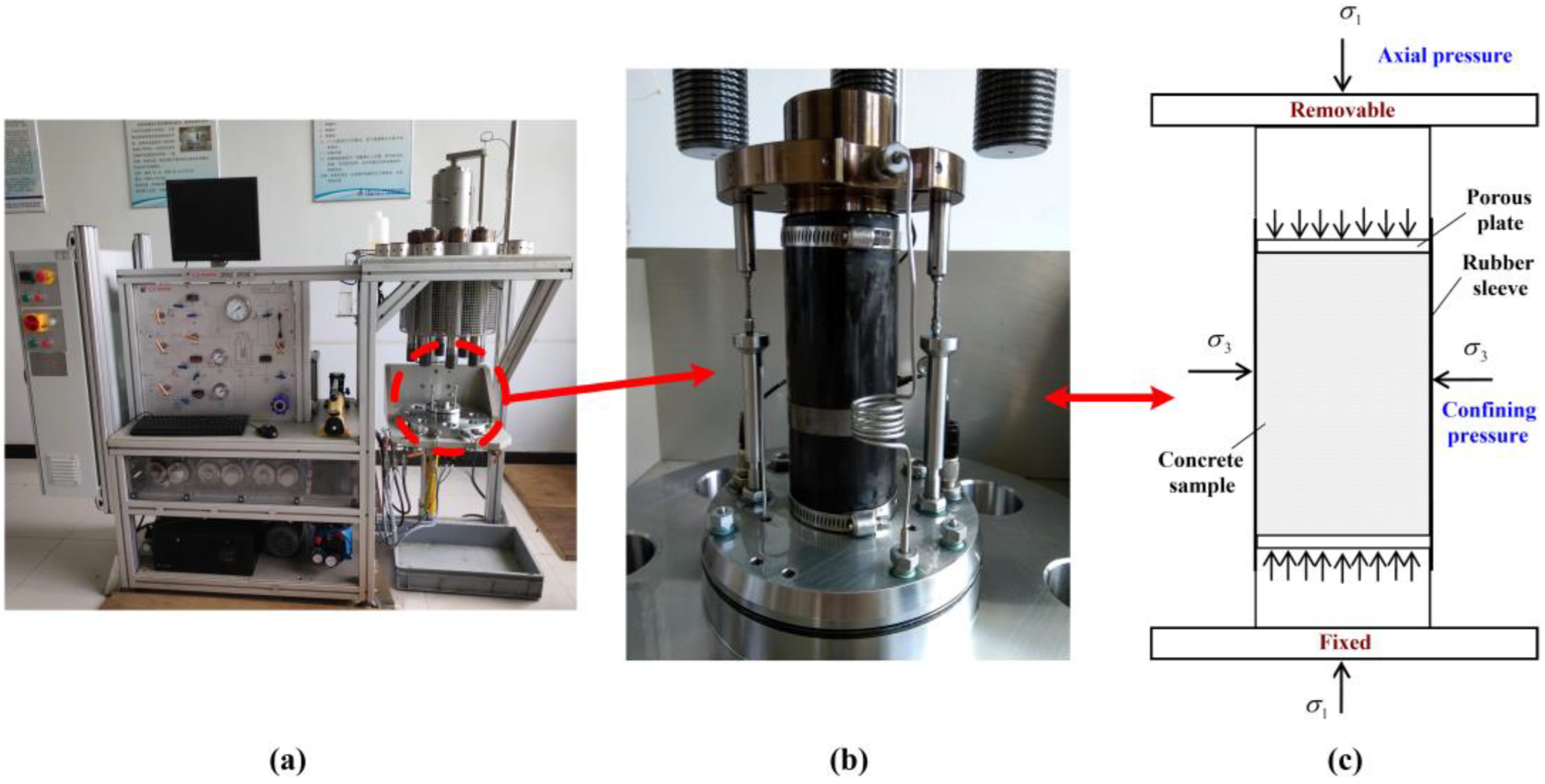

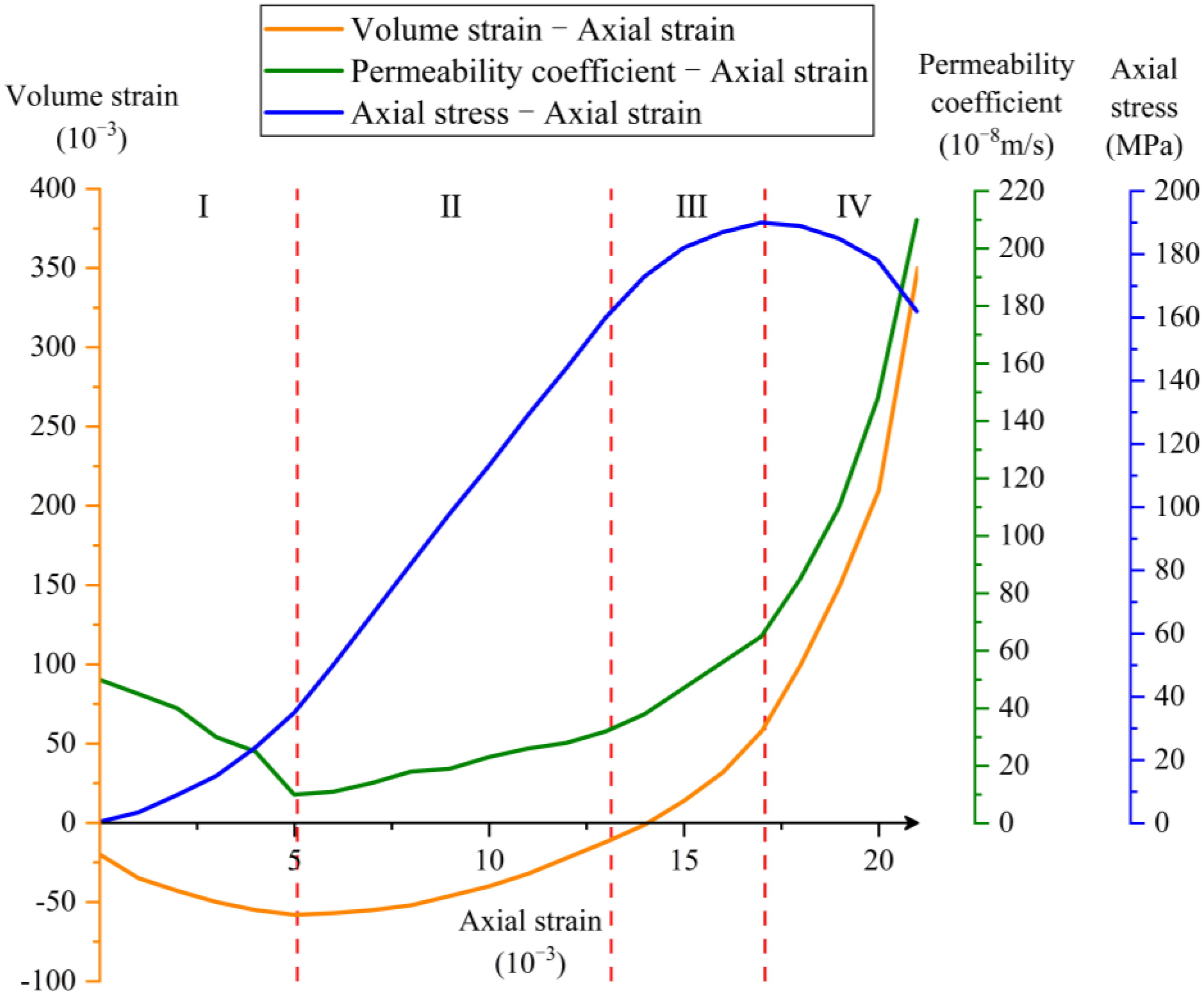
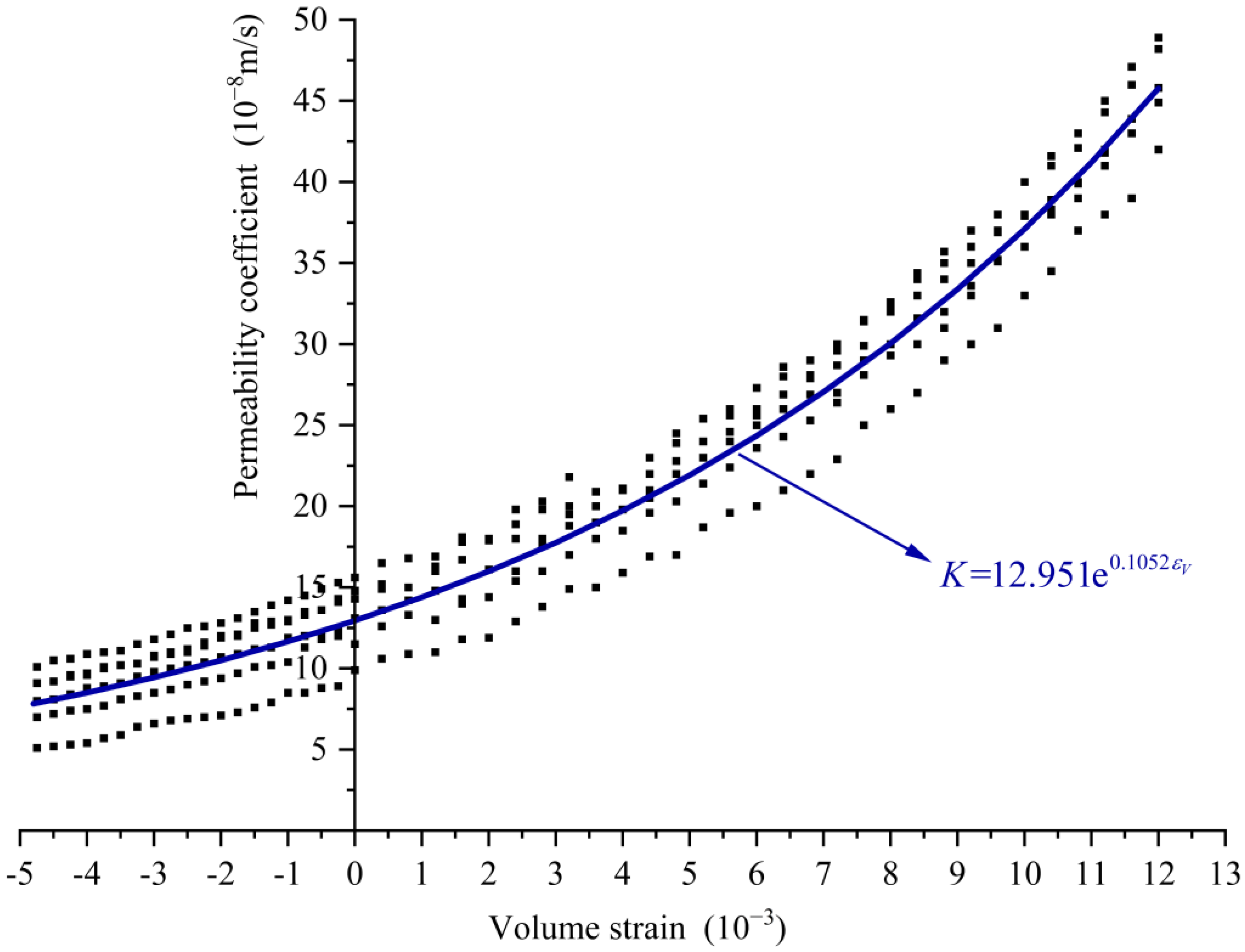
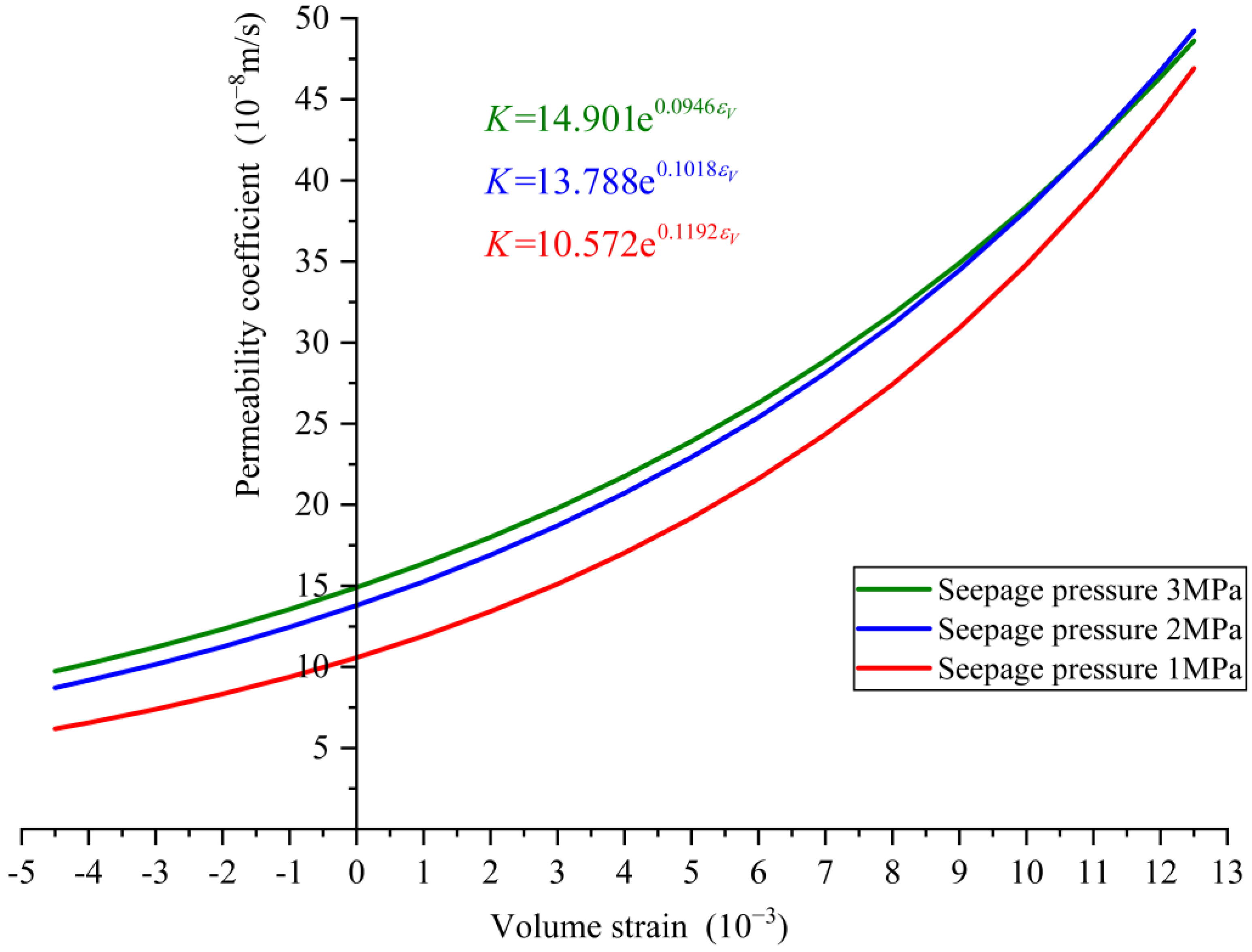


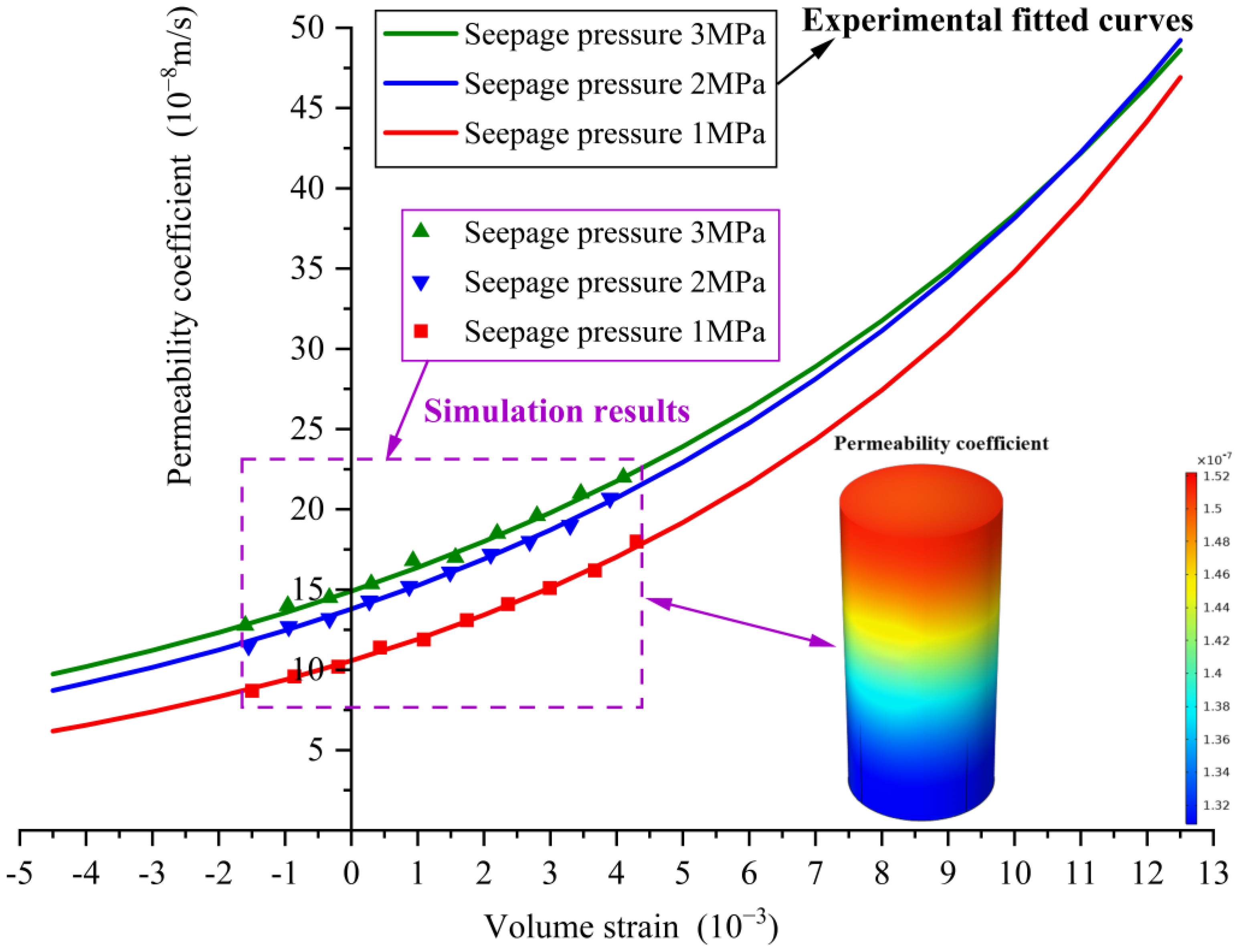
| Sample | Seepage Pressure (MPa) | Confining Pressure (MPa) | ||||
|---|---|---|---|---|---|---|
| 1# | 457.3 | 466.3 | 0.046 | 0.460 | 1 | 10 |
| 2# | 458.7 | 467.9 | 0.047 | 0.479 | 2 | 10 |
| 3# | 458.6 | 467.7 | 0.046 | 0.478 | 3 | 10 |
| 4# | 459.0 | 468.3 | 0.047 | 0.483 | 1 | 20 |
| 5# | 457.6 | 466.8 | 0.047 | 0.464 | 2 | 20 |
| 6# | 453.3 | 462.5 | 0.047 | 0.405 | 3 | 20 |
| Stage | Sign of Volume Strain | Change in Volume | Change in Permeability Coefficient |
|---|---|---|---|
| I | Negative | Compressed continuously | Decreased, and to minimum |
| II | Negative | Starts to expand, but overall compressed | Starts to increase slowly |
| III | Negative to positive | Expanded continuously | Accelerated increase |
| IV | Positive | Overall expanded | Increase rapidly |
Disclaimer/Publisher’s Note: The statements, opinions and data contained in all publications are solely those of the individual author(s) and contributor(s) and not of MDPI and/or the editor(s). MDPI and/or the editor(s) disclaim responsibility for any injury to people or property resulting from any ideas, methods, instructions or products referred to in the content. |
© 2023 by the authors. Licensee MDPI, Basel, Switzerland. This article is an open access article distributed under the terms and conditions of the Creative Commons Attribution (CC BY) license (https://creativecommons.org/licenses/by/4.0/).
Share and Cite
Gu, J.; Ren, Q.; Tao, M.; Han, Y.; Zhang, L. Permeability Coefficient of Concrete under Complex Stress States. Materials 2023, 16, 4368. https://doi.org/10.3390/ma16124368
Gu J, Ren Q, Tao M, Han Y, Zhang L. Permeability Coefficient of Concrete under Complex Stress States. Materials. 2023; 16(12):4368. https://doi.org/10.3390/ma16124368
Chicago/Turabian StyleGu, Jiafeng, Qingwen Ren, Mei Tao, Yan Han, and Linfei Zhang. 2023. "Permeability Coefficient of Concrete under Complex Stress States" Materials 16, no. 12: 4368. https://doi.org/10.3390/ma16124368




